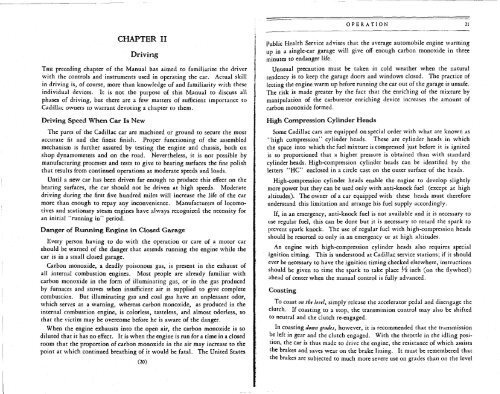1928 Cadillac - GM Heritage Center
1928 Cadillac - GM Heritage Center
1928 Cadillac - GM Heritage Center
You also want an ePaper? Increase the reach of your titles
YUMPU automatically turns print PDFs into web optimized ePapers that Google loves.
OPERATION 21<br />
CHAPTER II<br />
Driving<br />
THE preceding chapter of the Manual has aimed to familiarize the driver<br />
with the controls and instruments used in operating the car. Actual skill<br />
in driving is, of course, more than knowledge of and familiarity with these<br />
individual devices. It is not the purpose of this Manual to discuss all<br />
phases of driving, but there are a few matters of sufficient importance to<br />
<strong>Cadillac</strong> owners to warrant devoting a chapter to them.<br />
Driving Speed When Car Is New<br />
The parts of the <strong>Cadillac</strong> car are machined or ground to secure the most<br />
accurate fit and the finest finish. Proper functioning of the assembled<br />
mechanism is further assured by testing the engine and chassis, both on<br />
shop dynamometers and on the road. Nevertheless, it is not possible by<br />
manufacturing processes and tests to give to bearing surfaces the fine polish<br />
that results from continued operations at moderate speeds and loads.<br />
Until a new car has been driven far enough to produce this effect on the<br />
bearing surfaces, the car should not be driven at high speeds. Moderate<br />
driving during the first five hundred miles will increase the life of the car<br />
more than enough to repay any inconvenience. Manufacturers of locomotives<br />
and stationary steam engines have always recognized the necessity for<br />
an initial "running in" period.<br />
Danger of Running Engine in Closed Garage<br />
Every person having to do with the operation or care of a motor car<br />
should be warned of the danger that attends running the engine while the<br />
car is in a small closed garage.<br />
Carbon monoxide, a deadly poisonous gas, is present in the exhaust of<br />
all internal combustion engines. Most people are already familiar with<br />
carbon monoxide in the form of illuminating gas, or in the gas produced<br />
by furnaces and stoves when insufficient air is supplied to give complete<br />
combustion. But illuminating gas and coal gas have an unpleasant odor,<br />
which serves as a warning, whereas carbon monoxide, as produced in the<br />
internal combustion engine, is colorless, tasteless, and almost odorless, so<br />
that the victim may be overcome before he is aware of the danger.<br />
When the engine exhausts into the open air, the carbon monoxide is so<br />
diluted that it has no effect. It is when the engine is run for a time in a closed<br />
room that the proportion of carbon monoxide in the air may increase to the<br />
point at which continued breathing of it would be fatal. The United States<br />
(20)<br />
Public Health Service advises that the average automobile engine warming<br />
up in a single-car garage will give off enough carbon monoxide in three<br />
minutes to endanger life.<br />
Unusual precaution must be taken in cold weather when the natural<br />
tendency is to keep the garage doors and windows closed. The practice of<br />
letting the engine warm up before running the car out of the garage is unsafe.<br />
The risk is made greater by the fact that the enriching of the mixture by<br />
manipulation of the carburetor enriching device increases the amount of<br />
carbon monoxide formed.<br />
High Compression Cylinder Heads<br />
Some <strong>Cadillac</strong> cars are equipped on special order with what are known as<br />
"high compression" cylinder heads. These are cylinder heads in which<br />
the space into which the fuel mixture is compressed just before it is ignited<br />
is so proportioned that a higher pressure is obtained than with standard<br />
cylinder heads. High-compression cylinder heads can be identified by the<br />
letters "HC" enclosed in a circle cast on the outer surface of the heads.<br />
High-compression cylinder heads enable the engine to develop slightly<br />
more power but they can be used only with anti-knock fuel (except at high<br />
altitudes). The owner of a car equipped with these heads must therefore<br />
understand this limitation and arrange his fuel supply accordingly.<br />
If, in an emergency, anti-knock fuel is not available and it is necessary to<br />
use regular fuel, this can be done but it is necessary to retard the spark to<br />
prevent spark knock. The use of regular fuel with high-compression heads<br />
should be resorted to only in an emergency or at high altitudes.<br />
An engine with high-compression cylinder heads also requires special<br />
ignition timing. This is understood at <strong>Cadillac</strong> service stations; if it should<br />
ever be necessary to have the ignition timing checked elsewhere, instructions<br />
should be given to time the spark to take place X A. inch (on the flywheel)<br />
ahead of center when the manual control is fully advanced.<br />
Coasting<br />
To coast on the level, simply release the accelerator pedal and disengage the<br />
clutch. If coasting to a stop, the transmission control may also be shifted<br />
to neutral and the clutch re-engaged.<br />
In coasting down grades, however, it is recommended that the transmission<br />
be left in gear and the clutch engaged. With the throttle in the idling position,<br />
the car is thus made to drive the engine, the resistance of which assists<br />
the brakes and saves wear on the brake lining. It must be remembered that<br />
the brakes are subjected to much more severe use on grades than on the level
















